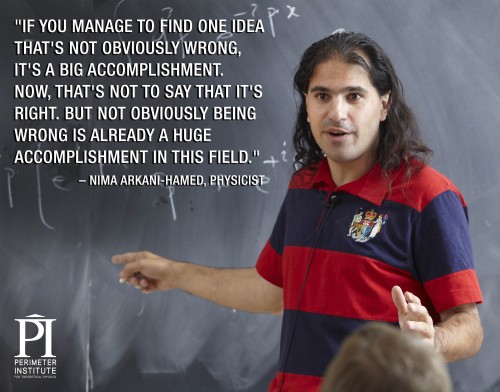
Revealing the secrets of space–time? (Courtesy: Perimeter Institute for Theoretical Physics)
By Tushna Commissariat
If you fancy a bit of late-night quantum mechanics, make sure that tonight you tune into the live webcast of “Quantum Mechanics and Spacetime in the 21st Century” – a lecture that by physicist Nima Arkani-Hamed as part of the Perimeter Institute’s Public Lecture Series. Arkani-Hamed, who won the inaugural Fundamental Physics Prize in 2012, says that he hasn’t “been this excited about physics in a very long time”. He will talk about how the most recent advances in quantum mechanics shed new light on our understanding of the universe’s fabric of time and space. In the past, Arkani-Hamed has shown how the weakness of gravity, compared with the other fundamental forces of nature, might be explained by the existence of extra dimensions of space. He has also recently been involved in the 2013 documentary Particle Fever, about the search for the Higgs boson.
The webcast will begin at 11.45 p.m. GMT (7 p.m. EST) and you can send questions to Arkani-Hamed by tweeting @Perimeter and using the hashtag #piLIVE. Take a look at a short teaser video for his talk below and tell us what you think about it in the comments section.
Trackback: Physics Viewpoint | A 21st-century discourse on quantum mechanics and space–time
If Nature’s space and time are really emerging entities, then all the laws of its different types of interactions: Gravity, EM, Weak, Strong, …, should be also be emerging and the fascinating thing will be to know the “unique source” of all of this.
I listened to his live broadcast and was amazed at his great enthusiasm about a concept which is as he had said was not obviously wrong which he feels is encouraging. The talk should have been about QM and Spacetime but we got a general talk about the possible critical importance of energy in spacetime, particularly at very high energies. Although he did not say so I got the impression he feels that a critical experimental study of particles at very very high energies could reveal the ultimate secrets and additional string theory dimensions of the universe and feels that at the relatively low LHC energy supersymmetry might not reveal any of its secrets. That naturally led him later to add that he looked forward to colliders at much much higher energies. So governments and research councils will have to continue pumping huge funds into colliders in the future to test string theory and supersymmetry. In a way he has a similar view as Hawking that the universe started as a singularity of infinite energy, mass and curvature and now it has expanded significantly and that will continue. The present energy of spacetime is far too low to all0w meaningful investigation of our ultimate realities and if we compress spacetime to a very small volume the energy will get very high and that would be revealing.
Well I do not think we can elucidate our ultimate physical realities through such studies. The P.Institute holds the view that our various physics ocncepts are on a collision course as they are diametrically opposed to one another. To me the problems of physics are first that there are some concepts which to me cannot be reflective of our realities. The infinitely small singularity of infinite energy in my opinion did not exist and our universe had an initial architectural design which made it possible to have quantum mechanics, relativity, matter, energy in a preconceived methodology. Science is able to elucidate how that occurred. We need to get our laws and concepts right. For instance there is this issue of the determinism view of Einstein as opposed to the indeterminism of QM, and the Einstein EPR and the Bohr Einstein debates etc followed by Bell’s Theorem. I believe that both Einstein and Bell are right and are not in contradiction and why because i believe that a deterministic period in the initial origin of the universe programmed the emergence of indeterminism in quantum mechanics. Without this combination of deterministic and indeteministic attributes there would not have been a universe with particles, atoms, molecules and consciousness and life. There are many other issues needing better interpretations and gradually we will know about the origin of our physical realities.In quantum mechanics as Einstein and coauthors argued there could exist hidden variables and therefore Quantum theory was incomplete. In my opinion hidden variables do exist but if they do they have no diect connection with superluminal speeds, for it is precisely this faster than light argument which creates confusion.
1. Indeed, the supposed Big Bang singularity is a problem: this leads immediately to the Planck energy of 1.22 10^16 TeV compared to the 14 TeV of the LHC. Is there some revealing physics in this vast range of energy? The problem is that we simply cannot have machines scanning this range of energy. Or is there is a “desert” in terms of physics beyond a certain attainable energy? One does not know though one has found cosmic rays with energies up to ~ 10^8 TeV. Hence, one has to find ways to deal with this existential problem.
2. As far as one knows the structure of the “local” classical physics(CP) is complete and it goes over smoothly to the “non-local” QP implying it being complete also. The presence of hidden variables will create another “local structure” beyond the QM, where the Planck constant h and the resultant intrinsic uncertainty due to the fundamental non-commutation of observables should be absent.
The particle physicist search for evidence of stings will lead ultimately to the creation of a super kamikaze collider-A collider that either bankrupts a government or destroys the earth in the process of proving a string theorist’s obsession.
Simply, there are not extra dimensions. Read: Against fantasy: in n no more than n. International Journal of Science and Research. V. 3 Issue 5, May 2014. pp 1646 – 1648.
Trackback: Blog - physicsworld.com